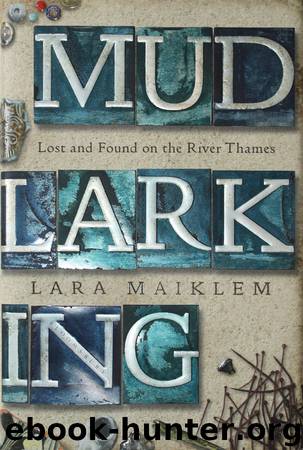Mudlarking by Lara Maiklem

Author:Lara Maiklem
Language: eng
Format: epub
Publisher: Bloomsbury Publishing
TOWER BEACH
Education she has none, and she never had instruction worthy the name. All her knowledge is to know the time of low water, and the value of the wrecks and waifs which each recurring tide scatters all too scantily over her peculiar domain.
Charles Manby Smith, ‘The Tide Waitress’, Curiosities of London Life or Phases, Physiological and Social of the Great Metropolis (1853)
Some people refer to the foreshore in front of the Tower of London as a beach and it certainly looks like one. But it’s not easy to get to. It is the stretch of foreshore on the north side of the river just to the west of Tower Bridge that runs the entire length of the Tower complex. I walked to it once, a number of years ago, along the foreshore from Custom House, a little further west where there are easy river stairs. I wasn’t planning to mudlark, I just wanted to have a look. That was on a particularly low tide and involved a lot of clambering over slimy wooden posts and wading through deep mud under jetties and piers, which I don’t like doing if I can avoid it. I recall collecting quite a bit of small change as I scrambled through the muddy obstacle course, emerging onto a wide stretch of completely empty yellow sand just beyond it.
I carried on towards Tower Bridge, past a wide stone staircase set into the river wall called Queen’s Stairs, which were last used by a queen, Queen Mary, in 1938. They would have been the easiest and safest way down onto the beach, but these days they are kept locked. There’s a tall gate halfway down that’s crowned by a row of spiked railings, which makes it impossible for anyone to scale. Lack of use has turned the lower steps, where the river covers them at high tide, dark emerald green with algae.
From the foreshore you can see a wide bricked-in arch in the river wall with the words ‘ENTRY TO THE TRAITOR’S GATE’ stencilled above it in large white capital letters. The river entrance was bricked up in the middle of the nineteenth century and Traitor’s Gate itself is on the other side of the wall. It was originally known as the Water Gate and was built in the late thirteenth century on the orders of Edward I to provide a convenient means to reach the Tower by barge. It acquired its present name in the sixteenth century, as the Tower evolved into a place of imprisonment, torture and beheading. Most famously, two of Henry VIII’s wives, Anne Boleyn and Catherine Howard, came this way by barge before meeting their fate at the Tower. Anne’s daughter, the future Elizabeth I, was luckier. She arrived at the Tower on Palm Sunday 1554, sick with fever, on the order of her half-sister, Queen Mary, who had accused her of plotting against her. Her barge had already shot the rapids under London Bridge on a low tide, which everyone
Download
This site does not store any files on its server. We only index and link to content provided by other sites. Please contact the content providers to delete copyright contents if any and email us, we'll remove relevant links or contents immediately.
Man-made Catastrophes and Risk Information Concealment by Dmitry Chernov & Didier Sornette(5923)
The Revenge of Geography: What the Map Tells Us About Coming Conflicts and the Battle Against Fate by Kaplan Robert D(4036)
Zero Waste Home by Bea Johnson(3781)
COSMOS by Carl Sagan(3554)
Good by S. Walden(3489)
In a Sunburned Country by Bill Bryson(3486)
The Fate of Rome: Climate, Disease, and the End of an Empire (The Princeton History of the Ancient World) by Kyle Harper(3003)
A Wilder Time by William E. Glassley(2818)
Camino Island by John Grisham(2763)
The Ogre by Doug Scott(2631)
Organic Mushroom Farming and Mycoremediation by Tradd Cotter(2630)
Human Dynamics Research in Smart and Connected Communities by Shih-Lung Shaw & Daniel Sui(2466)
Energy Myths and Realities by Vaclav Smil(2439)
The Traveler's Gift by Andy Andrews(2410)
9781803241661-PYTHON FOR ARCGIS PRO by Unknown(2323)
Inside the Middle East by Avi Melamed(2305)
Birds of New Guinea by Pratt Thane K.; Beehler Bruce M.; Anderton John C(2226)
A History of Warfare by John Keegan(2186)
And the Band Played On by Randy Shilts(2131)
